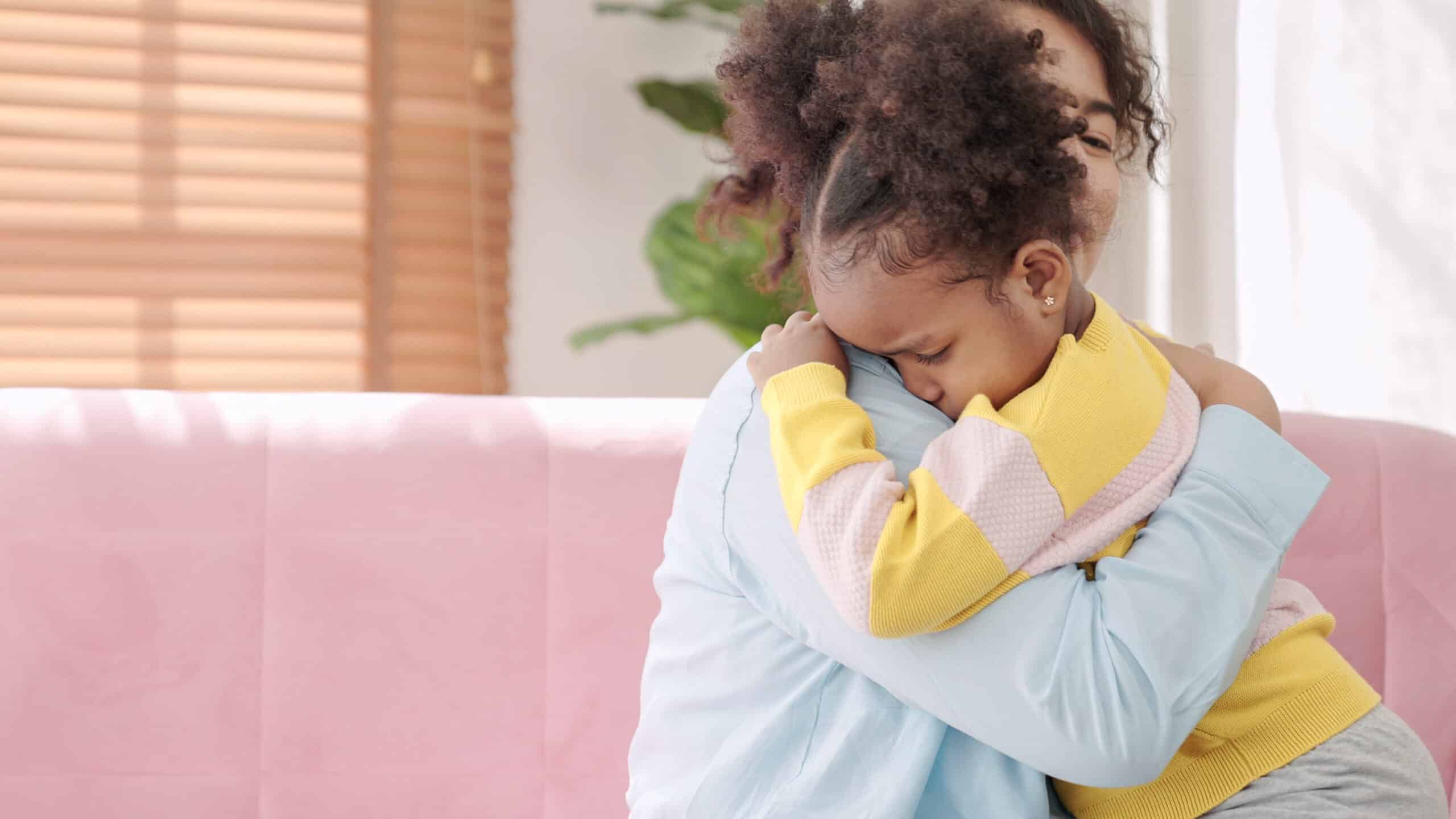Losing a pet is a difficult journey for anyone. Although there are some well-accepted stages of the grief process, each person is unique in how they will journey through that process. Parenting our children through that process compounds the complexity of the emotional path we must navigate. Not only are we attempting to acknowledge our own feelings, but we are also doing our best to support our children in what is often their first experience with death..

In my line of work, parents often ask how to help their children during this difficult time. They want to do the right thing, but they aren’t sure what the right thing is.To better understand how to help children through the loss of a pet, it is important to consider:
- A child’s perspective of death, which is often affected by any previous exposure to death and loss as well as
- Their development stage
- Their ability to cognitively appreciate what death is
The Elements of Death
There are four main elements of death, considered as different aspects of how the death of a pet or loved one is experienced.
- The biological element refers to the permanent cessation of life. A living creature is no longer living.
- The sociocultural element takes into consideration all of the various attitudes towards and concepts about death, which are often influenced by cultural norms.
- The spiritual element accounts for the belief, or not, in an afterlife for mind and soul.
- And lastly, the emotional element encompasses all of the emotions surrounding death such as anxiety, grief, and bereavement.
Death itself includes all of these elements. There is not one without the others, they are all co-existing and influencing our experience of death. This is true for adults. The same is true for children.
The Components of Death
Elements aside, there are some distinct components of understanding death.
- The irreversibility or permanence of death involves the understanding that death is a permanent state from which there is no return to life.
- The inevitability or universality of death is the understanding that all living things must die eventually; it’s an unavoidable reality for us and our pets.
- The applicability of death is the understanding that only living things can die. A rock isn’t alive, so a rock doesn’t die. How do we understand life, what has life, and what does not?
- The cessation of death refers to the understanding that all bodily processes cease to function upon death. Something that was living is no longer.
- Lastly, the causation of death is the understanding that death is ultimately caused by a breakdown of bodily functions. The cause of death is a dysfunction of life.
Each of these components are distinct, yet integral, pieces of understanding death. As a child develops, their ability to toggle and grasp at these concepts plays a major role in how they perceive death and loss.

Most Common Exposure to Death
For most children there are three key facilitators of introducing children to death. One, and perhaps the most influential, would be direct experience of death. This would include death of an immediate family member, close friend, or of course, a pet. How that death is internalized will depend on factors such as the closeness of relationship, exposure to the corpse, involvement in memorialization, and education on life and life cycle. Another key facilitator of exposure to death is parents, and specifically how and what parents communicate to their children about death. Parents have variable levels of willingness, availability and comfort discussing death with their children as well as role-modeling emotional awareness. The third key facilitator of exposure to death is media and the arts. Historically, this exposure came more through fairy tales and oral stories, but more recently through movies and shows. It is estimated that, on average, children under 8 years old spend 3 hours a day consuming media. Unfortunately, media portrayals of death are often confusing, unrealistic, and potentially even harmful.
Developmental Stages
As a generalization, children can be divided into four developmental stages: infants (0-2 years), young children (2-5 years), school-age children (6-10 years) and pre-teens/teens (11+ years). Of course, kids don’t follow a textbook and each child will be unique in their cognitive ability to understand death, but these are useful categories to help us appreciate what our children might be experiencing through the loss of a pet, and thus how we may best support them.
Infants (0-2 Years)
Although an infant cannot understand the elements and components of death, they can absolutely sense that something is different and they are in tune with emotions that their parents may be experiencing. The most common behavior I generally see from infants is the desire for reassurance. They may become concerned for the parent, or more clingy than usual, wanting to stay close to the parent or held by them. If the infant is closer to that 2 year old mark and aware of the pets’ presence in the household, they may perceive separation or abandonment as well. So, they don’t see it as death but they do sense an absence.
Young Children (2-5 Years)
Young children, or preschoolers, are busy and curious. They can usually appreciate the death of a pet in the moment, but they are not yet able to grasp the component of permanence, or irreversibility. This often leads to them asking the same questions repeatedly. Young children are very tactile learners and they may process their grief during play or drawing or talking with others. This age group loves to read with parents and reading together can be a wonderful tool for reinforcing the truths about death as well as role modeling the emotions of grief.
School-Age Children (6-10 Years)
As school-age children continue to mature, they begin to take on the cognitive ability to appreciate a more complete understanding of death. They tend to be very curious as well, and often ask questions about the physical aspects of death. Sometimes they’ll even come off as a little morbid, but it’s a genuine curiosity to understand. When these kids do understand, they may express anger. The best thing you can do when this happens is maintain a safe space, reassure them that these are normal feelings and it’s ok to feel them. School-age children may withdraw to process their emotions. If this is observed, give them the time and space they need. Talking with these kiddos and modeling grief for them can be very helpful. It’s okay for them to hear and see how others express themselves. They are learning to cope with and process the big feelings they have by observing others. Many school-age children have learned to read. There are some wonderful books for this age group that can be read together with a loved one or on their own.
Pre-Teens/Teens (11+ Years)
As children approach and reach puberty, the way that they handle their grief begins to shift. They are often more hesitant to express themselves openly and many times journaling or artistic expression is a useful tool to support them as they navigate the difficult feelings of loss. Another interesting consideration for this age group is that often they have grown up with and become very attached to their pets. This special bond makes the loss of their pet all the more difficult.

Communicating with Your Child
When talking to children about death and the loss of a pet, the most important consideration is their vocabulary. Their limited vocabulary is the single most significant difference between their ability to understand the conversation or not. It is appropriate to use accurate, clear, concrete language to talk with them in a way that makes sense to them. Keep things straight forward and simple.
Examples of accurate, clear, concrete language:
- “When an animal is hurting, we can choose to help him die.”
- “Fluffy died. Her body stopped working. We are very sad because we will miss her.”
- “His body will be taken to a room that gets really hot and will turn his body into ashes that sort of look like sand.”
It is best to avoid euphemisms such as:
- “Fluffy is going to go to sleep and not wake up.”
- “He passed away and moved on to a better place.”
As you communicate with children about death, I encourage you to maintain a stance of curiosity. Talk with the child about what they think of their pet, what their pet enjoyed, how they spent time together, and if they have any ideas of how they would like to say goodbye. Although you can tailor your language to the child’s needs, most children will benefit from an open, honest conversation about both the life and the death of their pet.

Practical Tips for Supporting Children
- Name the feeling! Children do not usually tame their emotions, but they don’t always know what it is they are feeling. Help them with the vocabulary and normalize what they are experiencing.
- Invite them into the memorialization process.
- If choosing euthanasia, allow them the choice to be present or not. Early exposure to death is a healthy stepping stone to how children will cope with death and loss in the future.
- Offer comfort and reassurance, but allow them to experience grief. It’s hard to watch our kids hurt, but unfortunately loss is a part of life that we all must experience at some point.
- Reading with children is proven to foster connection and provides a useful dialogue for difficult topics. There are many wonderful books available for all different ages.

A Final Note for Parents
You know your child better than anyone on the planet and you are equipped better than anyone else to support your child through this loss. Take care of yourself first, let your child observe your emotions, allow your child to ask questions and experience their own emotions, and offer comfort to them in that process. This time is tough. No way around it. With your support, though, your child will come out on the other side feeling loved, encouraged, and empowered.
Helpful Resources
- Two Hearts Pet Loss: Children in Grief
- Scroll down to the bottom of our Grief Support page for a list of children’s resources
Written by: Kellie Littrell, DVM, MPH, Colorado Caring Pathways Veterinarian
Dr. Kellie earned her veterinary degree from Texas A&M University in 2010 and practiced small animal medicine in Georgia before moving to Colorado in 2019. Throughout her career, she has always had a deep desire to bring comfort to her geriatric patients and help guide their owners through such a difficult time. Dr. Kellie feels blessed to be part of the Caring Pathways team and honored to serve families in their grieving.

